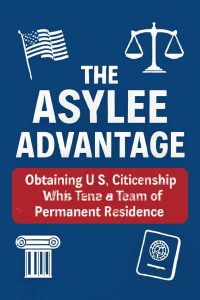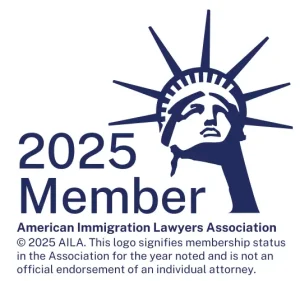Bottom Line Up Front: Asylees adjusting status under INA 209 face processing times of 29-45 months compared to family-based adjustments under INA 245 taking 12.5-20.5 months. The difference stems from unique documentation requirements, mandatory interviews, enhanced security screening, and specialized processing procedures that don’t apply to most other green card applicants.
Understanding the Two Pathways
When applying for a green card while in the United States, most immigrants file under INA Section 245 – the general adjustment of status provision. However, asylees must use a completely different legal pathway: INA Section 209(b), which contains specific requirements and procedures that significantly extend processing times.
INA 245: The Standard Route
Most immigrants – including those married to U.S. citizens, employment-based applicants, and diversity visa winners – adjust status under INA 245. This established process benefits from:
For more information on standard green card processes in Montana, see our comprehensive guide
- Streamlined procedures developed over decades
- High application volume that creates processing efficiency
- Optional interviews for many categories
- Fewer documentation requirements for admissibility
- No mandatory waiting periods after filing
INA 209: The Asylee-Specific Route
Asylees must use INA 209(b), which Congress designed specifically for those granted protection in the United States. This pathway includes additional safeguards and requirements that extend processing times significantly.
The Key Differences That Create Delays
1. Mandatory Physical Presence Documentation
INA 209 Requirement: Asylees must have been physically present in the United States for one year when USCIS adjudicates their Form I-485, not just when they file it. This creates unique documentation challenges.
Why It Delays Processing:
- USCIS must verify continuous physical presence, not just residence
- Officers must review extensive documentation proving day-by-day presence
- Any gaps in documentation trigger Requests for Evidence (RFEs)
- If USCIS cannot determine whether an applicant satisfies the one-year physical presence requirement, they may request additional evidence, and it might take longer to process
Documentation Challenges:
- School transcripts and attendance records
- Employment records showing daily work
- Medical records with appointment dates
- Utility bills and lease agreements
- Travel documents for any departures
- Affidavits from witnesses to physical presence
2. Enhanced Security and Background Checks
INA 209 Requirements: USCIS will determine, on a case-by-case basis, whether an interview by an immigration officer is necessary to determine the applicant’s admissibility, but interviews are significantly more common for asylees.
Why It Delays Processing:
- Enhanced security screening due to asylum background
- Review of entire asylum case file and decision
- Verification that asylum status remains valid
- Additional background checks through multiple agencies
- Case-by-case interview determinations add processing steps
3. Complex Inadmissibility Analysis
INA 209 Specifics: Because an asylee is not subject to admissibility grounds at the time of the asylum grant, the adjudication of the adjustment application may be the first instance that inadmissibility grounds are considered.
Processing Complications:
- Full medical examination required (unlike some INA 245 categories)
- The asylee is required to establish compliance with the vaccination requirements
- Comprehensive review of criminal and immigration history
- Waiver applications often needed for technical violations
4. Limited Waiver Options
INA 209 Restrictions: An applicant who is not admissible may have the grounds of inadmissibility waived except for those grounds under sections 212(a)(2)(C) and 212(a)(3)(A), (B), (C), or (E).
Why This Causes Delays:
- Careful legal analysis required for each inadmissibility ground
- Waiver applications (Form I-602) add months to processing
- Limited waiver availability creates complex eligibility determinations
- Officers must balance humanitarian factors against statutory restrictions
5. Comprehensive Review of Underlying Asylum Decision
INA 209 Requirement: In determining eligibility for adjustment of status of an alien with asylum status, the officer should review the underlying application (either Form I-589 or Form I-730) that provided the alien with asylum status.
Why This Creates Massive Delays:
- Complete legal re-examination: Officers must review the entire asylum case file and legal determination
- Fraud detection analysis: Officers look for new evidence that the original asylum grant was improper
- Ongoing refugee status verification: Determination of whether the person still meets the refugee definition
- Country condition updates: Research into whether conditions have changed since asylum was granted
- Identity reconciliation: Verification that the adjustment applicant is the same person granted asylum
Comparison to Other Categories:
- I-130 Family Cases: Simple relationship verification (marriage/birth certificates)
- I-140 Employment Cases: Job qualifications and labor certification review
- I-589 Asylum Reviews: Complex legal determination about persecution, credibility, and protection needs
Processing Impact: This represents a fundamental difference in complexity. While family and employment cases involve document verification, asylee cases require re-examining a sophisticated legal determination about persecution, credibility, and international protection – essentially a “second look” at the asylum decision itself.
6. Specialized Officer Training Requirements
Resource Allocation Issues:
- Fewer officers trained in both INA 209 procedures and asylum law complexities
- Unless a case is sent specifically to a field office for resolution of Terrorist Related Inadmissibility Ground (TRIG) issues, an officer should return any asylee adjustment case with unresolved TRIG issues to the originating service center
- Cases often transferred between offices for specialized review
- Limited processing capacity compared to high-volume INA 245 applications
Current Processing Time Reality
Recent Data Shows Significant Disparities
current USCIS processing time estimates
- Asylee Adjustments (INA 209): 29 to 45 months
- Family-based Adjustments (INA 245):5 to 20.5 months
- Refugee Adjustments (INA 209): 14 months (significantly faster than asylees)
Why Refugee Adjustments Are Faster
Refugees benefit from pre-screening overseas and often have:
- Complete documentation from refugee processing
- Medical examinations already completed
- Background checks conducted before U.S. entry
- Established identity verification
Document Preservation: Critical for Asylee Cases
Essential Records to Maintain
Asylum Documentation:
- Original asylum approval notice or court order
- All correspondence with immigration courts or USCIS
- Attorney representation records from asylum case
- Country condition evidence used in asylum case
Physical Presence Evidence:
- Employment Records: Pay stubs, W-2s, employment verification letters
- Educational Records: Transcripts, enrollment verification, attendance records
- Medical Records: Doctor visits, prescription records, hospital admissions
- Financial Records: Bank statements, tax returns, credit card statements
- Housing Records: Lease agreements, utility bills, mortgage statements
Travel Documentation:
- Any advance parole documents used
- Entry/exit stamps in passport
- Documentation of any emergency travel
- Refugee travel documents if applicable
Common Documentation Pitfalls
Insufficient Physical Presence Proof:
- Gaps in employment or school records
- Missing documentation for specific time periods
- Failure to document brief trips outside the U.S.
- Inadequate witness statements for undocumented periods
Medical Examination Issues:
- Using non-designated civil surgeons
- Incomplete vaccination records
- Expired medical examinations
- Missing required supplemental forms
When Waivers May Be Required
Common Inadmissibility Issues for Asylees
Immigration-Related Grounds:
- Unauthorized employment before asylum grant
- Unlawful presence accrual
- Document fraud during initial entry
- Failure to maintain status before asylum approval
Criminal Grounds:
- Minor criminal violations
- Arrests without convictions
- Civil violations treated as criminal matters
- Conduct occurring before asylum grant
Waiver Application Strategy
Form I-602 Applications:
- Filed concurrently with I-485 or separately
- An asylee adjustment applicant may have a ground of inadmissibility waived for humanitarian purposes, to assure family unity, or when it is otherwise in the public interest
- No extreme hardship requirement (unlike other waivers)
- Discretionary decisions requiring compelling evidence
The Role of Interviews in Delays
Why Asylee Interviews Are More Complex
Comprehensive Case Review:
- Verification of asylum claim validity
- Review of changed country conditions
- Assessment of continued refugee status
- Evaluation of family relationships for derivatives
Extended Interview Preparation:
- Review of entire asylum file
- Country condition research updates
- Security clearance verification
- Coordination between multiple USCIS offices
Planning Your Asylee Adjustment Strategy
Optimal Timing Considerations
When to File:
- Your application may be processed more quickly if you wait until 1 year after you are granted asylum to file Form I-485
- Ensure all required documentation is complete
- Consider concurrent filing of derivative applications
- Plan for potential RFEs and interview scheduling
Working with Experienced Counsel
Why Professional Guidance Matters:
- Complex interplay between asylum and adjustment law
- Waiver eligibility requires careful legal analysis
- Document preparation strategies can prevent delays
- Interview preparation for asylee-specific questions
Recent Policy Changes Affecting Processing
February 2023 USCIS Clarification
USCIS updated guidance to clarify that both asylees and refugees must have been physically present in the United States for one year when we adjudicate their Form I-485, rather than at the time they file their adjustment of status application.
Impact on Processing:
- Cases filed early may face longer adjudication waits
- Enhanced documentation requirements for physical presence
- Increased RFE rates for insufficient presence evidence
Conclusion
Facing asylee adjustment delays? Get experienced guidance from a Montana immigration attorney who understands the complexities of INA 209 cases.
The dramatic difference in processing times between INA 209 and INA 245 adjustments reflects the complexity and specialized nature of asylee cases. While family-based and employment adjustments follow well-established procedures with predictable timelines, asylee adjustments require individualized review of protection claims, enhanced security screening, and complex legal determinations.
Working with an experienced Montana immigration attorney can help navigate these complex requirements.
Understanding these differences helps asylees and their families plan appropriately for the extended timeline while taking steps to minimize delays through careful documentation and strategic timing of their applications.
Once you receive your green card, understand the asylee advantage for naturalization that allows citizenship after just 4 years.
Key Takeaways:
- Asylee adjustments take 2-3 times longer than standard family-based cases
- Physical presence documentation is the most common source of delays
- Professional legal assistance can help navigate complex waiver requirements
- Early preparation and comprehensive documentation are essential for success
This article provides general information about immigration law and should not be considered legal advice for your specific situation. For personalized guidance on your asylee adjustment case, consult with a qualified immigration attorney who can evaluate your individual circumstances.

